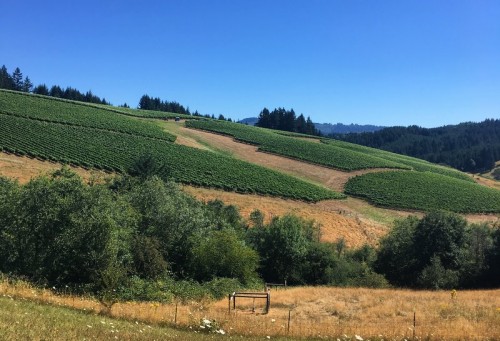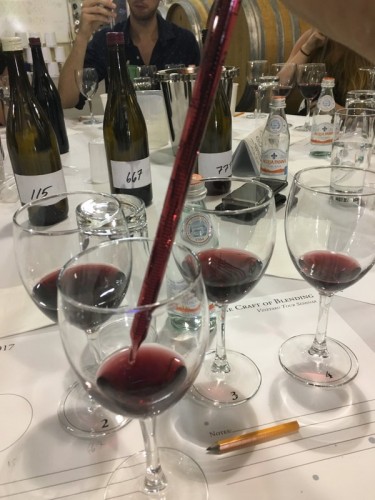
During the International Pinot Noir Celebration in Oregon, one of the events is a vineyard visit. The delegates are split into groups and each visits a different vineyard. Our group went to Willakenzie in Yamhill-Carlton.
During the visit we went to the cellar for a fun exercise. We were given three cask samples of the 2016 vintage Pinot Noir, each made from different clones. Our job was to taste them, then make our own blends.

First, 115. This was more bony and structured with nice freshness and brightness. Not so much upfront fruit character, but nice weight and focus.
Then 667. This, on its own, was the most complete of the wines. It was generous and balanced with sweet black fruits, some richness and good texture. Very stylish even at this early stage.
And 777. This is rich and fruit driven. Perhaps a little simple, but with some depth and sweetness. There’s a hint of cola character here, also.
So how do I choose what my blend is? I asked some advice.
‘Where do you want a wine to be?’ asks Willakenzie winemaker Eric Kramer. ‘You can go down the rabbit hole. Have a pretty clear vision and build to it.’
So what’s my goal? I want to make a wine that’s got some structure, but also finesse and elegance. I want something that’s going to develop in bottle, so it can’t give everything away straight away: it can’t just be about pretty sweet fruit.
So I start with a base of 115, and then add 667. I settle on 60:40 115 to 667. It’s quite grippy but there’s some flesh on the bones.
And to compare, 75% 667 and 25% 115. This is fleshier and more generous, but also has a bit of structure.
I decide to leave 777 out altogether, because I don’t think it brings anything to the party, and will just dilute the personality of the wine.
Which is the right blend? It’s hard to say. Only time will tell, and I suspect that there are many good blends, rather than one perfect one. But winemaking consultants, I’m sure, quite like the idea that the perfect blend is out there, and requires a stroke of genius to find.
Ultimately, if you start with great wines, then it’s hard to really mess up. But, still, there is an art to blending.
1 Comment on Blending Pinot Noir clones
Interesting post, Jamie. But I disagree with your suspicion about winemaking consultants.
As you point out, there is no perfect blend but there are hundreds, depending on what you want. Here you just had 3 wines but when you start throwing different types of barrel into the mix, even a small place might have 10 options to blend from and there are loads of other constraints – cost, tank sizes, required volumes, what are you going to do with the rest etc etc.
I guess what an experienced consultant can offer is to see the wood from the trees and be able to narrow down these options a lot. But even the top guys rarely get it “right” first time and you can end up going back and forwards or down blind alleys. Sometimes just 1 or 2% makes a massive difference.
Ultimately you are right, there are numerous good blends. It’s probably the most fun part of the job.